|

Carnivale on Shakespeare's Stage
Copyright © 2007 by Kristen McDermott.
Kristen McDermott is an Assistant Professor of English Literature at Central Michigan University, specializing in Early Modern English Studies (particularly Drama and Theater History) and Shakespeare. She attended Mythic Journeys '06 as a Guest Presenter. Prof. McDermott has edited a collection of dramatic texts for an undergraduate audience; Masques of Difference: Four Court Masques by Ben Jonson will be published by Manchester University Press in September 2007. She is also a member of the Executive Board of the Interstitial Arts Foundation.
[Photographs of Venetian revelers: © 2006 Visioneering International, Dahlan Robert Foah, used with permission. All rights reserved. No duplication permitted.]
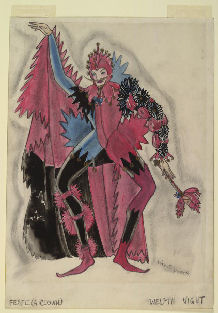
What, are there masques?
Clamber you not up to the casements then,
Nor thrust your head into the public street
To gaze on fools with varnished faces. . .
(The Merchant of Venice 2.5.27-32)
The funeral baked meats
Did coldly furnish forth the marriage tables.
(Hamlet 1.2.179-80)
Dost thou think that because thou art virtuous
there shall be no more cakes and ale?
(Twelfth Night 2.3.103-4)
Students of Shakespeare often struggle with the fact that his plays present a bewildering mixture of moods within a single act — even a single scene. A grieving prince holds a beloved friend's skull in his hands and jokes about its stench. A romantic comedy ends not with a marriage but with an enraged and bloodied retainer cursing the happy couples before he storms off the stage. A teenaged girl makes a bawdy pun just before sliding her lover's dagger into her own heart.
The notion of decorum — that only comedies should be funny and that tragedies should be solemn throughout, that comic characters only should speak coarsely or flippantly, while tragic heroes and heroines should speak in high poetic rhetoric — was an 18th-century convention that would have been alien to the sensibilities of an Elizabethan Londoner. Shakespeare and his contemporaries were comfortable with a complex mixture of the moral and amoral, the serious and irreverent, for the simple reason that the visual and performative arts in Europe had always been that way. It was only in Shakespeare's time that cultural critics began drawing clear, distinct lines between "popular" art and courtly, aristocratic, or elite art, and the motivation for such a division was largely the end (in England anyway) of the Catholic Church as the primary patron of the arts.
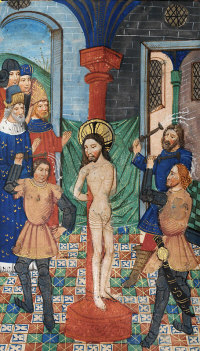 Medieval religious art can be, to the modern eye, a little strange. Illuminated scriptures feature marginal cartoons, lovingly rendered, of demons baring their genitals and animals defecating on the heads of hapless pilgrims. Portraits of the Virgin and Child exist in which the infant Christ happily opens his mouth to catch a stream of mother's milk jetting improbably from Mary's large and exposed breast. The beloved cycle plays of the 14th and 15th centuries — immediate sources for the popular drama of Shakespeare's time — juxtaposed solemn depictions of the Nativity and the Crucifixion with comic scenes of shepherds farting and stealing sheep, or torturers turning the scourging of Christ into a cruel dance. Medieval religious art can be, to the modern eye, a little strange. Illuminated scriptures feature marginal cartoons, lovingly rendered, of demons baring their genitals and animals defecating on the heads of hapless pilgrims. Portraits of the Virgin and Child exist in which the infant Christ happily opens his mouth to catch a stream of mother's milk jetting improbably from Mary's large and exposed breast. The beloved cycle plays of the 14th and 15th centuries — immediate sources for the popular drama of Shakespeare's time — juxtaposed solemn depictions of the Nativity and the Crucifixion with comic scenes of shepherds farting and stealing sheep, or torturers turning the scourging of Christ into a cruel dance.
The medieval Church acknowledged the eternal tension between the physical and the spiritual in both humankind and in the life of Christ. The Incarnation, with all its implications, was the central focus of its oral and pictorial teachings — those lessons directed to the illiterate majority of Christians — and any bizarre blendings of the sacred and the profane only enhanced the lesson that the miraculous could be part of everyday life, in all its earthiness, that the human soul was capable of perceiving the sacred in the secular and vice versa.
The moments of worship that focused most deeply on the mystery of the Incarnation were drawn from the scriptural depictions of the birth and death of Jesus Christ: those moments when the incarnated Godhead was most obviously human. Because the liturgical year was arranged around the Gospels that recounted the life and teachings of Christ, worshipers were exposed, year after year, to regular, cyclic retellings of incidents in Jesus's life. The Church also, of course, incorporated the rhythms of the agricultural year into those of the liturgical year. The stories of Christ's birth were recounted in the winter season that rural traditions had reserved for celebrating the return of the sun — the Winter Solstice, which was also the Roman feast of Saturnalia, co-opted by the early Church as the season of the Nativity, when the meek arrived to overthrow the strong. Not coincidentally, Saturnalia featured banquets at which wealthy nobles served their slaves and servants: such an inversion was seen as a necessary reminder of the sacred in social life.
Similarly, the stories of Christ's death occurred in the spring season of renewal and rebirth, perhaps coinciding with pagan celebrations of Eostre, an Anglo-Saxon goddess. Each moment of mystery — the birth and the death — was preceded by a long period of contemplative spiritual preparation: Advent in the winter and Lent in the spring. These preparatory seasons featured the denial of physical pleasures in eating, drinking, and sex, as a means to purge and purify the body to receive Christ (the Eucharist was normally received by commoners only at Christmas and Easter). Unsurprisingly, most people tended to begin and end these solemn periods by "storing up" such pleasures in binges of excessive eating and drinking, and the medieval Church gradually decided to make a virtue of necessity by licensing such overindulgences in rituals of festive celebration. Such seasons became known as Carnivale, a word possibly derived from the Latin carne vale, "farewell to the flesh," which described the practical necessity of cooking and eating all the available meat just prior to the meatless seasons of Lent and Advent.

But how do we get from pre-Lenten meat binges to Hamlet's sardonic "funeral baked meats"? What does a Protestant playwright's work have to do with medieval Catholic traditions? The scholarship of Jungian literary critics, sociologists interested in historical relationships between myth and culture, and the great Marxist scholar Mikhail Bakhtin, have all created a portrait of the Elizabethan theater as one of the most enduring and vital expressions of the "world upside down" aesthetic created by popular reactions to the attempts by the medieval Church to impose order on the rapidly changing world of Early Modern Europe.
The translation into English of Bakhtin's Rabelais and his World in 1968 had a profound effect on scholarship of the Early Modern (15th-17th centuries) period. Bakhtin's analysis of the cyclical tension between the authority of the medieval Catholic Church and the rebellious self-indulgence of rural folk festivals gave historians and literary scholars a new way to look at the complex interplay of sacred and profane imagery in the poetry and drama of Chaucer, Rabelais, Cervantes, Shakespeare, Donne, Milton, and their many contemporaries.
 In sum, Bakhtin argued that the ritual energies of Carnivale — which were designed by the church and by civic authorities to allow the common folk to blow off steam during the Christmas and pre-Lenten seasons — actually created a politically and socially subversive art form of their own, which took the form of the imagery of a "world upside down." He focused on two specific elements in popular art: heteroglossia — art that depicted or echoed a multiplicity of voices, in order to mirror the univocality of Church teachings — and the "grotesque body" — the site of energies and activities related to the "lower bodily stratum," most notably eating, drinking, and sex. In sum, Bakhtin argued that the ritual energies of Carnivale — which were designed by the church and by civic authorities to allow the common folk to blow off steam during the Christmas and pre-Lenten seasons — actually created a politically and socially subversive art form of their own, which took the form of the imagery of a "world upside down." He focused on two specific elements in popular art: heteroglossia — art that depicted or echoed a multiplicity of voices, in order to mirror the univocality of Church teachings — and the "grotesque body" — the site of energies and activities related to the "lower bodily stratum," most notably eating, drinking, and sex.
Bakhtin saw European popular culture in the Early Modern period as inherently "dialogic" — a never-ending conversation between the monolithic "truths" handed down by the twin authorities of Church and Crown, and the divergent and chaotic demands of real everyday life experienced by real everyday people. For Bakhtin, the language of the People — rough, irreverent, body-centered, and bawdy — was always threatening to drown out the moralistic pronouncements of Power, causing ever more intensified attempts to control human nature. The lower stratum, whether of the body or of the Body Politic, was a subversive force to be reckoned with at all times. Popular art therefore existed in the tense zone between what the People wanted to say or see and what the censoring Powers would allow.
That zone has also been associated (by sociologists like Victor Turner) with the anthropological concept of "liminal space" — those points in time or place that exist in-between boundaries and borders, and which are invoked in ritual time and action. The theatre, steeped as it is in ritual culture, is just such a liminal space, and it's no coincidence that those plays that were written as the professional theater was just beginning to make the transition from ritual activity to marketplace product are especially concerned with telling stories about what happens in the liminal spaces of culture. Therefore, Shakespeare's plays rely heavily on magic, ritual, myth, disguise, and the clash between Carnivalesque energies and institutions of authority.
Liminal spaces are places of mixture and mingling — of classes, of cultures, of dimensions of existence. The human and the divine meet in liminal space, as do the king and peasant, male and female, sacred and profane. As the first half of Shakespeare's The Winter's Tale comes to a close, the play's infant heroine, Perdita, has been left to die on a deserted beach. Her abandoner has just been pursued and eaten by a bear. An Old Shepherd stands on a beach staring down at the wailing, abandoned baby, and remarks to his son, who has just witnessed the retainer's grisly death, "Now bless thyself. Thou metst with things dying; I with things new-born." He recognizes that they are in the presence of mystic powers beyond his understanding, but that require acknowledgement: "'Tis a lucky day, boy, and we'll do good deeds on't" (3.3.104-23).
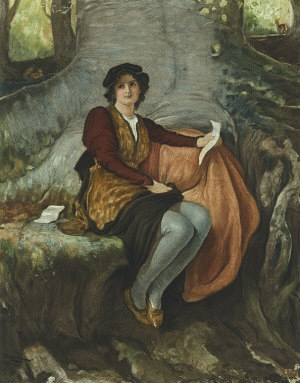 Shakespeare is always fascinated with characters who exist in that in-between space — and it is those characters who are endowed with the most powerful opportunities for truth-telling. His androgynous, plucky comic heroines, girls who disguise themselves convincingly as boys for a variety of reasons, use their transgendered status to speak truth about the tyrannies of love. In As You Like It, the witty Rosalind, taking advantage of her disguise as a boy to observe her lover's romantic style, mocks him to his face: "Men have died from time to time, and worms have eaten them, but not for love" (4.1.91-2). In Twelfth Night (a play, not coincidentally, named for the season of Christmas revelry), the heroine, Viola, has also disguised herself as a boy after being shipwrecked in an enemy land. She gains employment with a lovesick Count, with whom she promptly, hopelessly, falls in love. The Count sends her with messages of love to his lady, Olivia, a wealthy young woman who spurns his love and who becomes infatuated with Viola (disguised as Cesario) at first sight. Viola has no illusions about her situation: Shakespeare is always fascinated with characters who exist in that in-between space — and it is those characters who are endowed with the most powerful opportunities for truth-telling. His androgynous, plucky comic heroines, girls who disguise themselves convincingly as boys for a variety of reasons, use their transgendered status to speak truth about the tyrannies of love. In As You Like It, the witty Rosalind, taking advantage of her disguise as a boy to observe her lover's romantic style, mocks him to his face: "Men have died from time to time, and worms have eaten them, but not for love" (4.1.91-2). In Twelfth Night (a play, not coincidentally, named for the season of Christmas revelry), the heroine, Viola, has also disguised herself as a boy after being shipwrecked in an enemy land. She gains employment with a lovesick Count, with whom she promptly, hopelessly, falls in love. The Count sends her with messages of love to his lady, Olivia, a wealthy young woman who spurns his love and who becomes infatuated with Viola (disguised as Cesario) at first sight. Viola has no illusions about her situation:
-
-
What will become of this? As I am man,
My state is desperate for my master's love;
As I am woman — now alas the day! —
What thriftless sighs shall poor Olivia breathe!
O time! thou must untangle this, not I;
It is too hard a knot for me to untie!
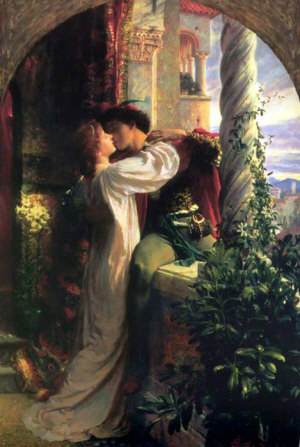 Shakespeare often has tremendous fun with the blurry and malleable nature of sex and gender — his heroines are equally attractive to both women and men, whether they present themselves as male or female. The fact that all Shakespeare's female characters were played by immensely talented adolescent males — a fact well known to his audience — only made the joke better. Love, in Shakespeare's comic world, is always pan-sexual, it always crosses class boundaries indiscriminately, and, no matter how hard the lovers try to characterize their love as divine and spiritual, we are always reminded that it is also about sex. When the virginal but enraptured Juliet tells her Romeo to "take all myself," and promises, Shakespeare often has tremendous fun with the blurry and malleable nature of sex and gender — his heroines are equally attractive to both women and men, whether they present themselves as male or female. The fact that all Shakespeare's female characters were played by immensely talented adolescent males — a fact well known to his audience — only made the joke better. Love, in Shakespeare's comic world, is always pan-sexual, it always crosses class boundaries indiscriminately, and, no matter how hard the lovers try to characterize their love as divine and spiritual, we are always reminded that it is also about sex. When the virginal but enraptured Juliet tells her Romeo to "take all myself," and promises,
-
-
My bounty is as boundless as the sea,
My love as deep; the more I give to thee,
The more I have, for both are infinite,
she remarks on both the sacredness of lust and the physicality of love — the "amorous rites" she shall soon learn in Romeo's arms (2.1.175-7).
Love in the comedies and tragedies alike is also often dogged by death, however — either the symbolic "little death" of orgasm or the real death of "star-cross'd lovers." "This is thy sheath," Juliet tells Romeo's dagger, meaning her heart, but also using the common slang term for a woman's vagina. Similarly, when Viola's Count realizes that his beloved Olivia loves the "boy," Cesario, he threatens to "sacrifice the lamb that I do love,/To spite a raven's heart within a dove." Viola immediately answers, "And I, most jocund, apt and willingly,/To do you rest, a thousand deaths would die" (5.1.126-9). It is at this liminal moment in the play that certain mayhem is interrupted by the miraculous appearance of Viola's lost twin, Sebastian, which solves all the love-riddles in an instant: "One face, one voice, one habit, and two persons,/A natural perspective, that is and is not!" The mystical twin becomes the answer to the greatest mystery of love: is it the body or the soul that we long to possess? Shakespeare lets his haughty aristocratic lovers, Orsino and Olivia, happily have it both ways, by creating a lover who is both male and female, one person and two, like the ancient shaman Teiresias.
Love has the power to overcome all boundaries in Shakespeare's comedies, but his comic worlds are by no means utopian — the awareness of class and power are always foregrounded. Shakespeare allows his witty jesters and fools (his most overtly liminal characters, ritual outsiders who use mimicry, ridicule, and song to satirize their culture) to dare to criticize those in power for forgotting themselves and their responsibilities. "Pray, good Madonna," Feste jokes with his mourning employer in Twelfth Night, "give me leave to prove you a fool":
-
-
FESTE: Good madonna, why mournest thou?
OLIVIA: Good fool, for my brother's death.
FESTE: I think his soul is in hell, madonna.
OLIVIA: I know his soul is in heaven, fool.
FESTE: The more fool, madonna, to mourn for your brother's soul being in heaven. Take away the fool, gentlemen. (1.5.50, 57-62)
In reminding her that the brother she mourns is happier in heaven than she is on earth, that her extended mourning is merely self-indulgent, he wins a tearful smile and helps her to return to the world of the living, simultaneously acting as a spirit guide and social critic. Through Twelfth Night, the great are instructed by the powerless that obsessions with love and honor are fruitless without genuine affection, that language itself is "a chev'rel glove — how easily may the wrong side be turned outward," and that the "whirligig of time" will inevitably come around to punish hypocrisy and reward fidelity (3.1.11).
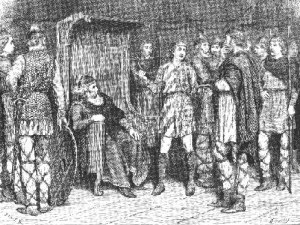 More tragically, in King Lear, an elderly king abdicates while refusing to give up the privileges of his rank, thereby becoming a king and not-king. He demands that his "loving" daughters and heirs, whose best interests are served by his speedy death, feed and house him in high style. Lear's jester laments his own in-between state, and compares it to his royal employer's: More tragically, in King Lear, an elderly king abdicates while refusing to give up the privileges of his rank, thereby becoming a king and not-king. He demands that his "loving" daughters and heirs, whose best interests are served by his speedy death, feed and house him in high style. Lear's jester laments his own in-between state, and compares it to his royal employer's:
-
-
thy daughters [will] . . . have me whipped for speaking true, thou'lt have me whipped for lying; and sometimes I am whipped for holding my peace. I had rather be any kind o' thing than a fool: and yet I would not be thee, nuncle; thou hast pared thy wit o' both sides, and left nothing i' the middle (1.4.159-64).
The line between power and powerlessness, truth and lies, a king and a fool, is blurred in this tragedy. In Lear, Shakespeare goes further than in any of his other plays in turning the world upside-down. All possible sources of authority and order — parental love, brotherly love, filial love, class, intellect, and piety — are demolished by the single decision of a foolish king. In the ruins of his kingdom, the only survivor is a disinherited son, Edgar, who escaped by disguising himself as a naked, insane beggar. In the final line of the play, he observes paradoxically, "The oldest hath borne most. We that are young/Shall never see so much, nor live so long" (5.3.325).
All Elizabethan playwrights made liberal use of the clown or jester in their comedies, but Shakespeare's innovation was to give his tragic heroes and heroines a share in the humble clown's propensity for sardonic humor. Hamlet observes to the frantic seekers of his lover's father's body — whom he has just mistakenly slaughtered — that the old man is "at a banquet — not where he eats, but where he is eaten." He taunts his uncle/stepfather, the current King of Denmark:
-
-
HAMLET: . . . your fat king and your lean beggar is but variable service, two dishes, but to one table: that's the end.
CLAUDIUS: Alas, alas!
HAMLET: A man may fish with the worm that hath eat of a king, and eat of the fish that hath fed of that worm.
CLAUDIUS: What dost you mean by this?
HAMLET: Nothing but to show you how a king may go a progress through the guts of a beggar.
CLAUDIUS: Where is Polonius?
HAMLET: In heaven; send hither to see: if your messenger find him not there, seek him i' the other place yourself. But indeed, if you find him not within this month, you shall nose him as you go up the stairs into the lobby.
The sick joke, at which Hamlet is adept, is the reminder that Claudius is as mortal as any man, that Hamlet has already sought to murder him once before, and will certainly do so again. Claudius, he implies, is a walking dead man, existing neither in heaven nor in hell, on earth or beyond, so long as Hamlet remains committed to killing him in revenge for his own father's murder.
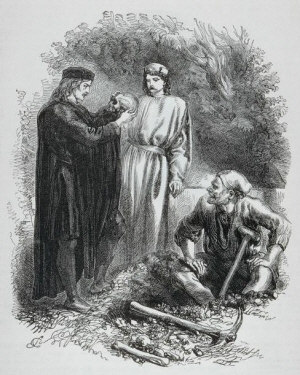 But what is "festive" or Carnivalesque about such a scene? The entire play, as Michael Bristol has argued, presents a disturbing critique of the uses and misuses of power. Hamlet takes on the voice of the powerless when he mocks Claudius, Polonius, and the structures of power. To Bristol, when Hamlet holds the skull of the jester Yorick in his hand, he demonstrates his purpose in life: to combine the roles of prince and jester, lover and killer, son and father, judge and criminal, all to instruct the state of Denmark that it will become irretrievably "rotten" unless the real alliances of love and kinship regain their power over the false ones of politics and expediency. At this moment in the play, Hamlet has miraculously escaped from his uncle's assassination plot, and knows that he is living on borrowed time: But what is "festive" or Carnivalesque about such a scene? The entire play, as Michael Bristol has argued, presents a disturbing critique of the uses and misuses of power. Hamlet takes on the voice of the powerless when he mocks Claudius, Polonius, and the structures of power. To Bristol, when Hamlet holds the skull of the jester Yorick in his hand, he demonstrates his purpose in life: to combine the roles of prince and jester, lover and killer, son and father, judge and criminal, all to instruct the state of Denmark that it will become irretrievably "rotten" unless the real alliances of love and kinship regain their power over the false ones of politics and expediency. At this moment in the play, Hamlet has miraculously escaped from his uncle's assassination plot, and knows that he is living on borrowed time:
-
-
the interim's mine;/And a man's life's no more than to say 'One.'
. . . we defy augury: there's a special providence in the fall of a sparrow. If it be now, 'tis not to come; if it be not to come, it will be now; if it be not now, yet it will come: the readiness is all (5.2.74-5, 157-60).
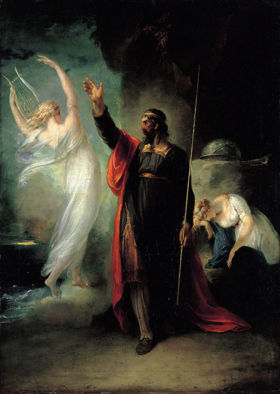 Time, occasion, power: all are meaningless in the long view to Hamlet. The important thing is to acknowledge one's kinship with the smallest and least.
Carnivale, then, is a reminder that the Christian worldview demands first and foremost that humans relinquish power. This had become, however, a lesson "more honored in the breach than the observance," to use Hamlet's phrase (1.4.17-8). The Church and the Crown depended on increasingly empty rituals of authority to exist; the rest of the world existed to mock those rituals. Since the penalty for such mockery was death, the subversive work often took place under the radar of authority, on the well-worn boards of the public stage, in an art form that had been officially labeled illegitimate and foolish when it was given the name of "play." Long after the English Protestant Church banished the idolatrous rituals of the Catholic Church, English audiences could still enjoy the delights and dangers of Carnivale on the public stage, a liminal space neither male nor female, real nor unreal, powerful nor powerless. In the words of Shakespeare's avatar, Prospero, the stage is a "bare island": Time, occasion, power: all are meaningless in the long view to Hamlet. The important thing is to acknowledge one's kinship with the smallest and least.
Carnivale, then, is a reminder that the Christian worldview demands first and foremost that humans relinquish power. This had become, however, a lesson "more honored in the breach than the observance," to use Hamlet's phrase (1.4.17-8). The Church and the Crown depended on increasingly empty rituals of authority to exist; the rest of the world existed to mock those rituals. Since the penalty for such mockery was death, the subversive work often took place under the radar of authority, on the well-worn boards of the public stage, in an art form that had been officially labeled illegitimate and foolish when it was given the name of "play." Long after the English Protestant Church banished the idolatrous rituals of the Catholic Church, English audiences could still enjoy the delights and dangers of Carnivale on the public stage, a liminal space neither male nor female, real nor unreal, powerful nor powerless. In the words of Shakespeare's avatar, Prospero, the stage is a "bare island":
-
- These our actors,
As I foretold you, were all spirits and
Are melted into air, into thin air:
And, like the baseless fabric of this vision,
The cloud-capp'd towers, the gorgeous palaces,
The solemn temples, the great globe itself,
Ye all which it inherit, shall dissolve
And, like this insubstantial pageant faded,
Leave not a rack behind (The Tempest 4.1.148-156).
The festive stage, like the noisy rituals of Carnivale, was powerful by the virtue of its very impermanence, which allowed it to utter the profoundest, most disturbing truths in the guise of "play."
Further Reading:
Babcock, Barbara. The Reversible World: Symbolic Inversion in Art and Society. Ithaca: Cornell UP, 1978.
Bakhtin, Mikhail. Rabelais and His World. Tr. Helen Iswolsky. Cambridge, Mass.: MIT Press, 1968.
----------. The Dialogic Imagination. Tr. Michael Holquist and Caryl Emerson. Austin: U of Texas P, 1981.
Barber, C.L. Shakespeare's Festive Comedies: A Study of Dramatic Form and its Relation to Social Custom. New York: Meridian, 1963.
Bristol. Michael D. Carnival and Theater: Plebeian Culture and the Structure of Authority in Renaissance England. London: Routledge, 1985.
----------. "'Funeral Bak'd-Meats': Carnival and the Carnivalesque in Hamlet." In Hamlet: Case Studies in Contemporary Criticism. Ed. Suzanne Wofford. New York: St. Martin's, 1994.
Castle, Terry. Masquerade and Civilization: The Carnivalesque in Eighteenth-Century English Culture and Fiction. London: Methuen, 1986.
Donaldson, Ian. The World Upside-Down: Comedy from Jonson to Fielding. Oxford: Oxford UP, 1970.
Girard, René. Violence and the Sacred. Tr. Patrick Gregory. Baltimore: Johns Hopkins UP, 1977.
Harp, Geoffrey Galt. On the Grotesque: Strategies of Contradiction in Art and Literature. Princeton: Princeton UP, 1982.
Huizinga, Johan. Homo Ludens: A Study of the Play Elements in Culture. New York: Harper & Row, 1970.
Kayser, Wolfgang, J. The Grotesque in Art and Literature. Tr. Ulrich Weisstein. New York: Columbia UP, 1981.
Kolve, V.A. The Play Called Corpus Christi. New York: E. Arnold, 1966.
Kott, Ian. The Bottom Translation: Marlowe and Shakespeare and the Carnival Tradition. Evanston: Northwestern UP, 1987.
Laroque, François. Shakespeare's Festive World: Seasonal Entertainment and the Professional Stage. Tr. Janet Lloyd. Cambridge: Cambridge UP, 1993.
Marcus, Leah S. The Politics of Mirth: Herrick, Milton, Marvell, and the Defense of Old Holiday Pastimes. Chicago: U Chicago P, 1986.
Stallybrass, Peter, and Allon White. The Politics and Poetics of Transgression. London: Methuen, 1986.
Turner, Victor. From Ritual to Theatre: The Human Seriousness of Play. New York: Performing Arts Journal Publications, 1982.
----------. The Ritual Process: Structure and Anti-Structure. London: Routledge & Kegan Paul, 1969.
Read more about Kristen McDermott
Return to Mythic Passages Menu
Subscribe to the Mythic Passages e-magazine
|

